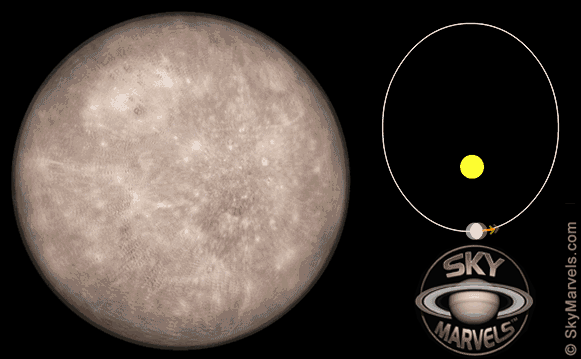I’ve heard of hogget. Almost certainly from cooking shows where they
show how you can make good dishes from cheaper cuts of meat.
ETA, although it doesn’t seem to be any cheaper than lamb… !
I’ve heard of hogget. Almost certainly from cooking shows where they
show how you can make good dishes from cheaper cuts of meat.
ETA, although it doesn’t seem to be any cheaper than lamb… !
Hmm. I checked this out in Celestia, because I was sure something odd was going to happen. As seen from a certain point on Mercury’s surface, the Sun rises, then slows down and appears to go backwards; but it doesn’t disappear under the horizon again before it resumes its motion in the forwards direction. I think the ‘backwards’ movement is less than a solar diameter, so no double sunrise. You can get half a sunrise, then the Sun goes down again, then rises again.
Celestia’s orbital elements are extraordinarily accurate, so this should be reliable.
This animation shows a very small reversal of direction at one point, which is the moment when the double sunrise/sunset occurs (on different limbs of the planet, of course); it is not enough to allow a complete sunrise, but the Sun will go backwards for a very short period.

I wouldn’t say it is common here; known of perhaps. I may have seen or heard the word used once or twice in my life.
Wouldn’t it really only be used by sheep ranchers? Farming has a whole argot unto itself.
TIL about the grisly murder in Hautefaye, France, that happened in 1870. Surprised it hasn’t been referenced more often (or perhaps it has and I’ve missed it).
That was a really interesting read. Sadly, I can well imagine circumstances that might precipitate a similar homicidal frenzy in the current American political climate.
Change a few names and particulars and the Hautefaye Case could easily be a 1950’s southern gothic tragedy.
You might need it if the trailer brakes weren’t linked to the truck brakes.
This word was coined in 1977 in a newspaper contest:
aibohphobia
The fear of palindromes.
The world’s longest conveyor belt runs for 98 kilometers and can be seen from space.
World’s Longest Conveyor Belt System – 61 Miles Long (scitechdaily.com)
It transports phosphate from a mine in the Western Sahara to a port on the Atlantic coast.
Do we see the conveyor belt or a cleared area around it? The article doesn’t say it can be seen from the moon so I guess possible on a clear day with enough magnification.
Clap!Clap!Clap!
(!palC!palC!palC)
[Music]
On a Clear Day
On a Clear Day
You can see Conveyor
Conveyor
Conveyer
Conveyer More
[/Music]
More of a random observation than a fact here. I was peeling apples to make applesauce one night. I use whatever apple varieties we have on hand, and living next to an orchard there are usually a few. I noticed that each apple variety peel tastes markedly different.
My gf called bullshit on my observation. She then had me eat small pieces of various peels (with my eyes closed) and I was able to ID the apple varieties. Granny Smith apple peels taste horrible. Rome apple peels taste bland. Honey Crisp peels taste delicious.
Which is why you should be including the peels in the sauce. I core the apples, then cook until tender, then run through the blender, then cook until smooth.
I’ll do that next batch.
I like to peel/core/chop then put them in a crockpot set on low when I go to bed. In the morning there is warm applesauce to eat with breakfast or refrigerate for lunch/dinner. I also like to add a bag of cranberries for taste and color.
I think what is shown in the photo is a berm supporting the belt, plus dust being blown off the top, rather than the belt itself. So, it’s a bit of an exaggeration to say the belt can be seen from space.
I am not sure: on the one hand you are right, you clearly see the settled dust (the wind obviously blows mostly from the North), but on the other hand the article states that the belt carries 2,000 tons/hour, that is 33 tons/minute, which is a lot. Must be quite a big belt, not only long but also pretty wide.
If the numbers are correct, of course. They very often are not in this kind of article, but that is another kind of interesting fact: why do numbers in popular articles fluctuate randomly? OK, let’s check:
The article also states that
According to the U.S. Geological Survey (USGS), Morocco and Western Sahara produce about 38 million metric tons of phosphate rock a year, which was 17 percent of global production in 2021.
38.000.000 divided by 365 and by 24 equals 4,338 tons/hour. So assuming this mine produces half of the region’s phosphate the assertion would be correct. If it is the only mine there it would produce even double what the article writes. Assuming they don’t transport half the production by lorry and half by belt, which sounds absurd. So the number seems plausible.
It’s a shame the term for the fear of the number thirteen is seventeen letters long.